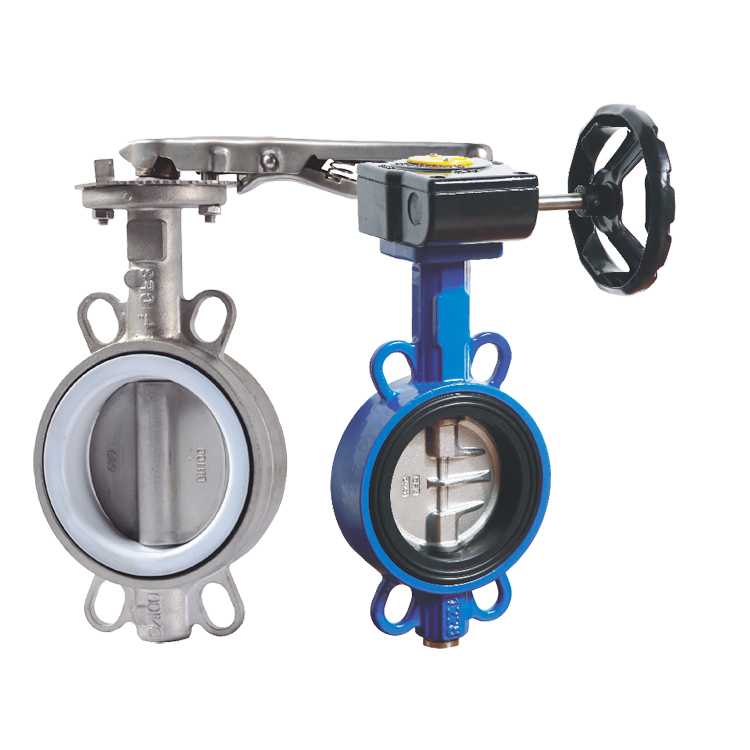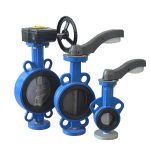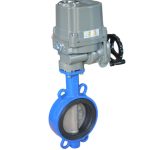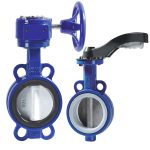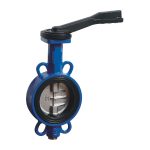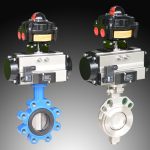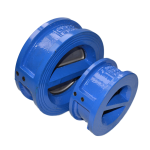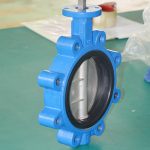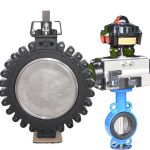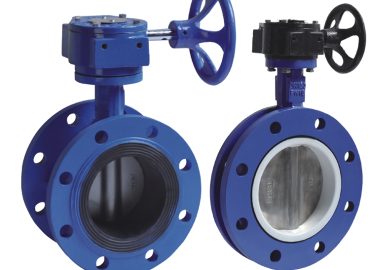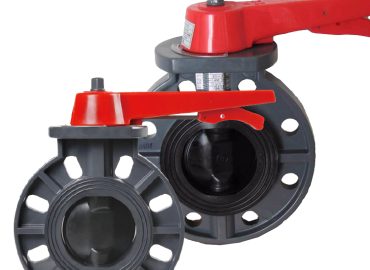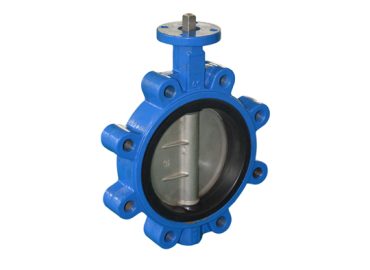Selecting the appropriate wafer valve type is a critical decision that can significantly impact the efficiency, safety, and reliability of various industrial processes. With a wide range of wafer valve types available, each with its unique features and applications, it’s essential to thoroughly evaluate multiple factors before making a choice. This blog post will guide you through the key considerations when selecting an appropriate wafer valve type, including understanding the specific application requirements, exploring different valve types, material selection, actuation options, and compliance with industry standards. By taking these factors into account, you can make an informed decision that ensures optimal performance and longevity for your chosen wafer valve.
Introduction
Selecting the appropriate wafer pneumatic butterfly valve type is a crucial aspect of designing and maintaining an efficient, safe, and reliable industrial process. Numerous factors must be taken into consideration to ensure that the chosen valve meets the specific requirements of the application. First and foremost, it’s essential to understand the system’s pressure and temperature ratings, flow rate, and flow control requirements to select a valve with suitable performance characteristics. Additionally, the compatibility of the valve materials with the media being handled is vital to prevent corrosion, leakage, and premature wear. The available installation space and maintenance considerations also play a significant role in determining the most suitable valve type. With various wafer valve types on the market, such as butterfly, check, plug, ball, diaphragm, gate, and knife gate valves, each having their unique features and applications, a thorough comparison is necessary to identify the best match. Furthermore, the choice of valve materials, actuation options (manual, pneumatic, electric, or hydraulic), and compliance with industry standards and certifications are all essential elements to consider. By carefully evaluating these factors and consulting with experts and suppliers, you can make an informed decision that ensures optimal performance, durability, and overall satisfaction with your selected wafer valve type.
Brief overview of wafer valves
Wafer valves are a category of industrial valves designed with a compact and lightweight form factor, making them an ideal choice for various applications where space constraints and ease of installation are crucial. These valves feature a wafer-style body that fits between two flanges in the pipeline, held in place by bolts that pass through both flanges and the valve body. Wafer valves serve various purposes, including flow regulation, isolation, and check (non-return) functions. Available in multiple types such as butterfly, check, plug, ball, diaphragm, gate, and knife gate valves, each offers distinct features and benefits tailored to specific applications and industries. The selection of the appropriate wafer valve type is vital for achieving optimal performance, reliability, and longevity in a given system. By understanding the unique characteristics of each wafer valve type and considering factors such as application requirements, material compatibility, actuation options, and industry standards, one can make an informed decision when selecting the most suitable wafer valve for their needs.
Importance of selecting the right wafer valve type
The importance of selecting the right wafer valve type cannot be overstated, as it directly impacts the efficiency, safety, and reliability of industrial processes. Choosing the appropriate valve ensures that the system operates smoothly, minimizing the risk of downtime and potential damage to equipment. An incorrect valve type may lead to issues like leakage, pressure loss, or inadequate flow control, resulting in suboptimal performance and increased maintenance costs. Additionally, proper valve selection is crucial for ensuring compatibility with the media being handled, preventing corrosion and premature wear. By carefully considering factors such as application requirements, material selection, actuation options, and industry standards, the right wafer valve type can be chosen to provide long-lasting performance and optimal functionality. In turn, this leads to higher productivity, reduced operational costs, and enhanced safety across various industries and applications.

Understanding the Application Requirements
Understanding the application requirements is a critical step in selecting the appropriate wafer valve type for an industrial process. To ensure optimal performance, safety, and reliability, several aspects must be considered. Firstly, the system’s pressure and temperature ratings are crucial, as the chosen valve must be able to withstand the operating conditions without compromising its integrity or functionality. Secondly, flow rate and flow control requirements play a significant role in determining the suitable valve type. Some valves offer precise flow control, while others are better suited for on/off applications or preventing backflow. Thirdly, media compatibility is essential to consider, as the valve materials must be resistant to corrosion and chemical reactions with the media being handled, such as liquids, gases, or slurries. Furthermore, installation space constraints must also be taken into account, as certain wafer valve types may be more compact and easier to install in tight spaces. Lastly, maintenance and operational considerations, including ease of access for repairs, serviceability, and the availability of replacement parts, should be assessed to ensure that the chosen valve type aligns with the long-term needs of the system. By thoroughly evaluating these factors, one can make an informed decision and select the most suitable wafer valve type for their specific application, ultimately leading to enhanced performance, durability, and overall satisfaction.
System pressure and temperature ratings
System pressure and temperature ratings are vital factors to consider when selecting the appropriate wafer valve type for an industrial process. These ratings indicate the maximum pressure and temperature that a valve can safely withstand while maintaining its functionality and structural integrity. Choosing a valve with suitable pressure and temperature ratings is crucial for ensuring the safety, reliability, and longevity of both the valve and the entire system. An inadequate valve may be susceptible to leakage, damage, or even catastrophic failure under high pressure or extreme temperature conditions, leading to potential downtime, increased maintenance costs, and safety hazards. To make an informed decision, it’s essential to thoroughly understand the operating conditions of the system and select a wafer valve type that meets or exceeds the required pressure and temperature ratings, thereby providing optimal performance and durability in the given application.
Flow rate and flow control requirements
Flow rate and flow control requirements are critical aspects to consider when selecting the ideal wafer valve type for a specific industrial process. The flow rate refers to the volume of media passing through the valve per unit of time, while flow control is the ability to regulate or adjust the flow rate within the system. Different wafer valve types offer varying levels of flow control capabilities, from simple on/off functionality to precise modulation of flow. Selecting a valve that meets the flow rate and control requirements of the application is essential for ensuring optimal system performance, efficiency, and safety. Inaccurate flow control can lead to pressure fluctuations, inadequate process control, and potential damage to equipment. By carefully evaluating the flow rate and control needs of the system and choosing a wafer valve type that aligns with these requirements, one can achieve a stable, efficient, and reliable process that minimizes downtime and maintenance costs while maximizing productivity and overall satisfaction.

Media type and compatibility
Media type and compatibility are crucial factors to consider when selecting the appropriate wafer valve type for an industrial process. The term “media” refers to the substance flowing through the valve, which can be a liquid, gas, or slurry. Different media types have unique properties and characteristics that can affect the performance and durability of the valve materials. For example, some media may be corrosive, abrasive, or prone to causing chemical reactions with certain materials. To ensure the longevity and reliability of the valve and the entire system, it is vital to choose a wafer valve made from materials that are resistant to corrosion and compatible with the specific media being handled. Incompatible valve materials can lead to leakage, premature wear, and even failure of the valve, resulting in increased maintenance costs, downtime, and potential safety hazards. By thoroughly understanding the properties of the media and selecting a wafer valve type with suitable material compatibility, one can optimize the performance and durability of the valve, ensuring a safe, efficient, and reliable industrial process.
Installation space constraints
Installation space constraints play a significant role in selecting the appropriate wafer valve type for an industrial process. In many applications, available space for installing valves and related equipment can be limited, making it crucial to choose a valve design that is compact and easy to install without compromising performance or functionality. Wafer valves, with their slim profile and ability to fit between pipeline flanges, offer a space-saving solution for various industries and applications. However, different wafer valve types may have varying dimensions and installation requirements, so it is essential to consider the specific constraints of the system when choosing the ideal valve. Factors such as valve orientation, accessibility for maintenance, and actuation options should also be taken into account to ensure a seamless integration with the existing infrastructure. By carefully evaluating the installation space constraints and selecting a wafer valve type that meets these requirements, one can achieve a reliable, efficient, and space-efficient solution for their industrial process, ultimately maximizing productivity and minimizing downtime.
Maintenance and operational considerations
Maintenance and operational considerations are essential factors when selecting the appropriate wafer valve type for an industrial process. Different valve types have varying requirements for maintenance, inspection, and servicing, which can impact the overall cost and efficiency of the system. A valve with low maintenance requirements and easy access for inspection can significantly reduce downtime and associated costs, while a valve that is difficult to maintain or requires frequent servicing may lead to inefficiencies and increased expenses. Additionally, operational considerations such as actuation options, response times, and ease of integration with existing control systems should be taken into account to ensure seamless operation and optimal performance. By carefully evaluating the maintenance and operational needs of the system and choosing a wafer valve type that aligns with these requirements, one can achieve a reliable, efficient, and cost-effective solution for their industrial process, ultimately maximizing productivity and minimizing downtime.
Types of Wafer Valves
Wafer valves, known for their slim profile and ability to fit between pipeline flanges, come in a variety of types, each designed to meet specific flow control requirements and applications across diverse industries. One of the most common wafer valve types is the butterfly valve, which consists of a circular disc mounted on a rotating shaft, enabling it to open or close the flow path with a simple quarter-turn motion. Butterfly valves are widely used for on/off isolation and flow control applications due to their quick operation, cost-effectiveness, and low maintenance requirements. Another type of wafer valve is the diaphragm valve, which uses a flexible diaphragm to regulate the flow by moving up and down against a weir or saddle. Diaphragm valves are particularly suitable for handling corrosive, abrasive, or high-purity media, as the diaphragm provides excellent sealing and isolates the fluid from the valve’s mechanical components. Ball valves, while not exclusive to the wafer design, can also be found in wafer-style configurations. These valves feature a spherical ball with a hole through its center, allowing for precise flow control when rotated. Wafer ball valves are often used in high-pressure applications and situations where tight shutoff is necessary. Lastly, check valves, specifically wafer-style check valves, are designed to prevent backflow in piping systems by allowing fluid to flow in only one direction. These valves typically utilize a swinging or spring-assisted disc mechanism that closes automatically when the flow reverses, providing reliable protection against potential damage caused by backflow. By understanding the various types of wafer valves and their unique features, one can select the most appropriate valve type for their specific industrial process, ensuring optimal performance, efficiency, and reliability.
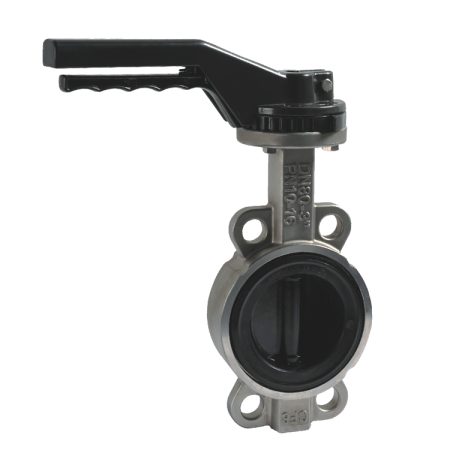
Butterfly valves
Butterfly valves are a popular type of quarter-turn valve widely used in various industries for their simplicity, efficiency, and cost-effectiveness. These valves consist of a circular disc attached to a rotating shaft, which, when turned, either opens or closes the flow path within a pipeline system. Butterfly valve offer quick and easy operation, making them ideal for on/off isolation and basic flow control applications. They are commonly found in industries such as water treatment, chemical processing, and HVAC systems due to their compatibility with a wide range of media and operating conditions. Additionally, butterfly valves are known for their compact design and low maintenance requirements, which contribute to their overall affordability and reliability. However, it is essential to consider that butterfly valves may have limitations in handling high-pressure applications or providing precise flow control compared to other valve types, such as control valves.
Check valves
Check valves are specialized types of valves designed to allow fluid flow in one direction while preventing backflow, ensuring the proper functioning and safety of a piping system. They operate automatically, responding to changes in fluid pressure and flow direction without the need for external actuation. When fluid flows in the desired direction, the internal mechanism (such as a swinging or spring-assisted disc) opens, allowing the fluid to pass through. If the flow reverses, the mechanism closes, effectively blocking the backflow and protecting the system from potential damage. Check valves are commonly used in applications such as water supply systems, chemical processing plants, and pump systems, where maintaining the unidirectional flow is crucial for optimal performance. Despite their simplicity, check valves play a vital role in preserving the integrity of a piping system and ensuring the efficient and reliable delivery of fluids across various industries.
Plug valves
Plug valves are a type of rotary valve widely used in various industries for their reliable performance and straightforward design. They function by utilizing a tapered or cylindrical plug with a hole through its center, which is rotated within the valve body to control the flow of fluid. When the plug is aligned with the flow path, fluid can freely pass through the valve; when turned perpendicular to the flow, the fluid passage is blocked, effectively stopping the flow. Plug valves offer excellent shutoff capabilities and can handle a wide range of media, including liquids, gases, and even slurries. They are commonly employed in applications such as chemical processing, petrochemicals, and water treatment, where quick and efficient flow control is essential. Furthermore, plug valves are known for their durability and low maintenance requirements, making them a cost-effective option in many industrial settings. However, it is essential to consider that plug valves may not be suitable for high-pressure applications or precise flow control, as they are primarily designed for on/off isolation purposes.
Ball valves
Ball valves are a widely used type of valve in various industries, known for their simple design and reliable performance. They operate by using a spherical ball with a hole through its center, which is rotated within the valve body to control the flow of fluid. When the hole in the ball is aligned with the flow path, fluid can pass through, while turning the ball 90 degrees perpendicular to the flow blocks the passage, effectively stopping the flow. Ball valves offer excellent shutoff capabilities, making them ideal for on/off isolation purposes. They are commonly employed in applications such as water systems, gas pipelines, and chemical processing, where quick and efficient flow control is essential. Furthermore, ball valves are known for their durability, low maintenance requirements, and ability to handle high pressures and temperatures, making them a versatile and cost-effective option in many industrial settings. However, it is essential to consider that ball valves may not be suitable for precise flow control or throttling applications, as they are primarily designed for on/off operation.
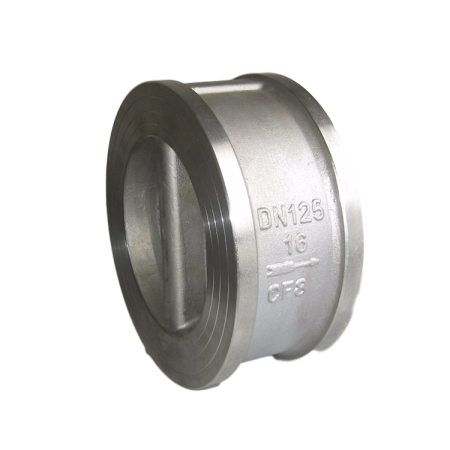
Diaphragm valves
Diaphragm valves are a unique type of valve specifically designed to handle sensitive, corrosive, or abrasive media in various industries. They operate by using a flexible diaphragm that moves up and down within the valve body to control fluid flow. When the diaphragm is lowered, it seals against a contoured seat, effectively stopping the flow, while raising the diaphragm allows fluid to pass through. One of the key advantages of diaphragm valves is their ability to isolate the fluid from the valve’s moving parts, which minimizes the risk of contamination and reduces maintenance requirements. This makes them particularly suitable for applications in industries like pharmaceuticals, food processing, and biotech, where maintaining a sterile environment is critical. Additionally, diaphragm valves can handle a wide range of media, including slurries and viscous fluids, thanks to their linear flow characteristics and minimal pressure drop. However, diaphragm valves may not be suitable for high-pressure or high-temperature applications, as the diaphragm’s material could be susceptible to degradation under such conditions.
Gate valves
Gate valves are a widely used type of valve known for their ability to provide reliable on/off isolation in various fluid handling systems. They operate by using a flat or wedge-shaped gate that moves vertically within the valve body to control the flow of fluid. When the gate is fully raised, fluid can pass through unobstructed, while lowering the gate blocks the fluid passage, effectively stopping the flow. Gate valves offer minimal pressure drop when fully open, making them suitable for applications where low resistance to flow is desired. They are commonly employed in industries such as water treatment, oil and gas, and chemical processing, where large diameter pipelines and infrequent operation are common. However, gate valves are not well-suited for throttling or precise flow control applications, as the gate’s design can lead to vibration, erosion, or damage when partially open. Additionally, gate valves can be slower to operate compared to other valve types, due to the required vertical movement of the gate, and may require more maintenance due to potential leakage around the stem.
Knife gate valves
Knife gate valves are a specialized type of gate valve designed to handle challenging media, such as slurries, viscous fluids, or solids in suspension. They operate using a thin, sharp-edged gate that moves vertically within the valve body to control the flow of fluid. When the gate is fully raised, fluid can pass through unobstructed, while lowering the gate slices through the media and blocks the passage, effectively stopping the flow. The unique design of the knife gate allows it to cut through suspended solids and prevent clogging, making it particularly suitable for applications in industries like pulp and paper, wastewater treatment, and mining, where handling abrasive or fibrous media is common. Knife gate valves offer minimal pressure drop when fully open and provide reliable on/off isolation. However, they may not be suitable for high-pressure or high-temperature applications, and are not designed for precise flow control or throttling purposes. Additionally, knife gate valves may require more maintenance due to potential leakage around the packing and possible wear of the gate’s cutting edge.
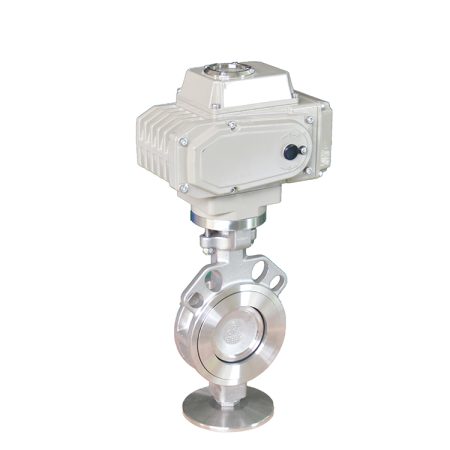
Comparison of each type’s features and applications
Valves play a crucial role in fluid handling systems, and various types of valves cater to different applications based on their features and design. Plug valves, known for their simple and reliable operation, are commonly used in chemical processing and water treatment applications for quick, efficient flow control. Butterfly valves, with their compact design and affordability, are ideal for low-pressure applications where basic flow control is needed, such as HVAC and water distribution systems. Control valves, designed for precision, are used in complex systems that require accurate regulation of flow rate, pressure, or temperature, making them suitable for use in industries like petrochemicals and power generation.
Ball valves, known for their durability and ability to handle high pressures and temperatures, are widely used in gas pipelines and water systems for on/off isolation. Diaphragm valves, designed for handling sensitive, corrosive, or abrasive media, are favored in pharmaceuticals, food processing, and biotech industries, where maintaining a sterile environment is critical. Gate valves, offering minimal pressure drop when fully open, are ideal for large diameter pipelines in water treatment, oil and gas, and chemical processing industries. Knife gate valves, specifically designed to handle challenging media such as slurries or solids in suspension, find their applications in pulp and paper, wastewater treatment, and mining industries.
In summary, each type of valve offers unique features and capabilities, making them suitable for specific applications and industries. Choosing the right valve depends on factors such as required flow control, pressure, temperature, and the nature of the media being handled.
Factors to Consider when Selecting a Wafer Valve Type
When selecting a wafer valve type for a particular application, several factors must be taken into consideration to ensure optimal performance and reliability. One of the foremost factors is the nature of the media being handled, as different valve types are designed to accommodate specific media properties, such as viscosity, corrosiveness, or abrasiveness. Understanding the intended flow control requirements is also crucial, as some valves, like control valves, offer precise regulation of flow rate, pressure, or temperature, while others, like butterfly valves, provide basic flow control. Operating conditions, including pressure and temperature ranges, should be assessed to determine the appropriate valve material and design suitable for withstanding these conditions without compromising performance or durability.
The required level of sealing performance is another important factor, as certain valve types, such as ball valves, provide excellent shutoff capabilities, while others, like butterfly valves, may have limited sealing capabilities in high-pressure applications. Installation space constraints must be considered, as some valves, like butterfly valves, have a compact design, making them ideal for tight spaces, whereas others, like gate valves, require more room. Ease of maintenance, as well as the frequency of operation, should also be evaluated, since some valves, like diaphragm valves, have minimal moving parts and require less maintenance, while others, like knife gate valves, may need more frequent servicing due to potential wear or leakage issues.
Additionally, the overall cost of the valve, including its initial purchase price, installation, and long-term maintenance expenses, should be weighed against its expected performance and lifespan to determine the best value for a given application. Ultimately, selecting the right wafer valve type involves carefully considering these factors in conjunction with the specific requirements of the application, ensuring that the chosen valve will perform efficiently, reliably, and safely throughout its intended service life.
Material selection
Material selection is a crucial aspect of valve design, as it directly affects the performance, durability, and compatibility of the valve with the media being handled and the operating conditions of the system. Various materials are available for valve construction, including metals like brass, stainless steel, and cast iron, as well as non-metallic materials like PVC, CPVC, and PTFE. Each material offers its unique properties, such as corrosion resistance, temperature tolerance, and mechanical strength, making them suitable for different applications and industries. When selecting a material, it is essential to consider factors such as the corrosiveness or abrasiveness of the media, the operating pressure and temperature ranges, and the required level of chemical compatibility. For instance, stainless steel valves may be preferred in high-pressure or high-temperature applications, while PVC or CPVC valves might be more appropriate for handling corrosive chemicals at lower pressures and temperatures. Additionally, material selection should take into account regulatory requirements and industry standards for specific applications, such as those found in the food processing, pharmaceutical, or petrochemical industries. By carefully considering these factors, the appropriate material can be selected to ensure optimal valve performance, longevity, and safety in the intended application.
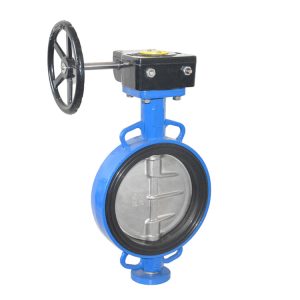
Valve size and end connections
Valve size and end connections are essential factors to consider when selecting a valve for a fluid handling system, as they directly impact the compatibility, installation, and performance of the valve within the system. The valve size, typically denoted by its nominal diameter (DN) or nominal pipe size (NPS), should be chosen based on the flow requirements of the system, taking into account factors such as flow rate, pressure drop, and the nature of the media being handled. Proper sizing ensures that the valve operates efficiently and effectively, without causing undue pressure loss or compromising flow control.
End connections play a crucial role in determining how the valve will be integrated into the piping system and can vary depending on the specific valve type and application requirements. Common end connection types include threaded, flanged, welded, and wafer-style connections. Threaded connections are suitable for smaller valve sizes and lower pressure applications, offering ease of installation and maintenance. Flanged connections are widely used for larger valves and higher pressure systems, providing a secure and leak-tight seal between the valve and adjacent piping. Welded connections offer a permanent, strong bond for high-pressure or high-temperature applications, such as those found in power plants or oil and gas industries. Wafer-style connections are ideal for compact spaces and quick installation, often used with butterfly valves or check valves.
Selecting the appropriate valve size and end connections is vital to ensure seamless integration, reliable operation, and ease of maintenance within the fluid handling system. It is essential to carefully evaluate the specific requirements of the application and consult with experts or refer to industry standards when making these critical decisions.
Actuation options
Actuation options play a significant role in determining the functionality, control, and efficiency of a valve within a fluid handling system. Actuators are devices that convert an external energy source into mechanical motion, enabling the valve to perform its intended function, such as opening, closing, or modulating flow. Various actuation options are available, including manual, electrical, pneumatic, and hydraulic actuators, each offering their unique set of advantages and limitations.
Manual actuators, such as handwheels or levers, are simple and cost-effective, suitable for smaller valves and applications where precise control or remote operation is not required. Electrical actuators use electric motors to control valve position and offer the advantages of remote operation, accurate positioning, and easy integration with automation systems. They are widely used in various industries, including water treatment, HVAC, and process control systems.
Pneumatic actuators rely on compressed air to generate the necessary force to operate the valve, providing rapid response times, high torque output, and compatibility with hazardous environments. They are commonly used in oil and gas, chemical processing, and power generation industries. Hydraulic actuators utilize pressurized fluid to control valve movement, offering high force output and precise control, making them suitable for high-pressure or heavy-duty applications.
When selecting an actuation option, it is essential to consider factors such as the required level of control, response time, available power sources, environmental conditions, and overall system requirements. By carefully assessing these factors, the appropriate actuation option can be chosen to ensure optimal valve performance, reliability, and integration within the fluid handling system.
Industry standards and certifications
Industry standards and certifications play a pivotal role in ensuring the quality, safety, and reliability of valves used in fluid handling systems across various sectors. These standards, established by recognized organizations such as the American Petroleum Institute (API), the International Organization for Standardization (ISO), and the American Society of Mechanical Engineers (ASME), provide guidelines and specifications for valve design, materials, manufacturing, testing, and performance. Adherence to these standards helps ensure that valves meet the stringent requirements of their intended applications and deliver consistent performance throughout their service life.
Certifications, on the other hand, are granted by independent bodies or agencies that assess and verify a valve’s conformity with specific industry standards or regulatory requirements. Certifications, such as those issued by the National Sanitation Foundation (NSF) for potable water applications or the American Bureau of Shipping (ABS) for marine and offshore applications, provide an added layer of assurance that the valve meets the necessary criteria for its intended use.
When selecting a valve for a particular application, it is crucial to consider the relevant industry standards and certifications to ensure compatibility, safety, and optimal performance. This not only helps maintain the integrity and efficiency of the fluid handling system but also contributes to the safety of personnel, equipment, and the environment. By choosing valves that comply with the appropriate standards and certifications, end-users can have confidence in the quality and reliability of their chosen products, minimizing the risk of failure, downtime, and potential hazards.

Case Studies: Selecting the Right Wafer Valve for Specific Applications
Case studies provide valuable insights into the process of selecting the right wafer valve for specific applications, highlighting the importance of considering various factors and industry requirements to ensure optimal performance, reliability, and safety. In one such case study, a chemical processing plant required a wafer valve solution for controlling the flow of highly corrosive media. After assessing the operating conditions, including pressure, temperature, and the aggressive nature of the media, the plant engineers decided on a lined butterfly valve with PTFE lining and a Hastelloy disc. This choice provided excellent corrosion resistance, reliable sealing performance, and compatibility with the existing piping system, ensuring efficient flow control and extending the service life of the valve.
In another case study involving a food processing facility, the selection of the appropriate wafer valve was critical for maintaining sanitary conditions and adhering to strict regulatory requirements. The facility needed a valve that would allow easy cleaning, minimize contamination risks, and offer precise flow control. After evaluating various options, the engineers chose a diaphragm valve with a stainless steel body and an FDA-approved elastomeric diaphragm. This valve type not only met the hygienic standards but also provided the desired level of flow control and ease of maintenance, contributing to the overall efficiency and safety of the facility’s processes.
In a third case study, a power generation plant needed to replace aging gate valves in its cooling water system with more reliable and efficient wafer valves. The engineers considered factors such as pressure drop, flow requirements, and space constraints before opting for double-eccentric butterfly valves with a robust, corrosion-resistant coating. These valves offered minimal pressure loss, quick operation, and a compact design, improving the overall efficiency and reliability of the cooling water system.
These case studies demonstrate the importance of carefully evaluating application-specific factors, industry standards, and regulatory requirements when selecting the right wafer valve. By doing so, engineers can ensure that the chosen valve meets the necessary criteria for performance, reliability, and safety, ultimately contributing to the success of the overall fluid handling system.
Water treatment plants
Water treatment plants play a crucial role in ensuring the availability of clean and safe water for communities, industries, and ecosystems. These facilities process raw water from various sources, such as rivers, lakes, and groundwater, through a series of physical, chemical, and biological treatment processes to remove contaminants and impurities. The treatment process typically involves steps such as coagulation, sedimentation, filtration, and disinfection to eliminate harmful substances like bacteria, viruses, algae, fungi, minerals, and organic compounds. By providing treated water that meets stringent quality standards, water treatment plants contribute significantly to public health, economic development, and environmental sustainability. They also help mitigate water scarcity issues by enabling the reuse of wastewater, promoting water conservation, and ensuring the long-term availability of this vital resource.
Chemical processing facilities
Chemical processing facilities are essential components of the modern industrial landscape, transforming raw materials into valuable products that drive various sectors, including pharmaceuticals, agriculture, consumer goods, and energy. These complex plants employ a wide range of chemical reactions and physical processes, such as synthesis, separation, and purification, to convert feedstocks like crude oil, natural gas, minerals, and biomass into a diverse array of chemicals and materials. Operating under strict safety and environmental regulations, chemical processing facilities prioritize the efficient use of resources, waste minimization, and pollution prevention. By continually investing in research and development, these facilities strive to innovate and adopt cutting-edge technologies that enhance process efficiency, product quality, and sustainability. Consequently, chemical processing facilities play a critical role in supporting economic growth, improving living standards, and addressing global challenges like climate change and resource scarcity.
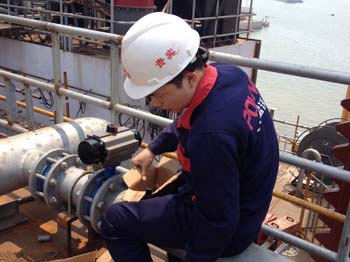
Food and beverage industry
The food and beverage industry is a vital sector that encompasses the production, processing, and distribution of a wide variety of consumable products, ranging from fresh produce and dairy to packaged goods and alcoholic beverages. This diverse industry plays a significant role in nourishing the global population, stimulating economic growth, and providing employment opportunities across the entire supply chain – from agriculture and manufacturing to retail and hospitality. As consumer preferences evolve and demand for healthier, more sustainable, and convenient options increases, the food and beverage industry must continuously innovate and adapt to meet these expectations. This includes investing in advanced technologies, such as automation, digitalization, and traceability systems, to enhance efficiency, safety, and transparency throughout the production process. Furthermore, the industry faces ongoing challenges related to food waste, packaging waste, and environmental sustainability, requiring proactive efforts to minimize its ecological footprint and contribute to a more sustainable future.
Oil and gas industry
The oil and gas industry plays a pivotal role in powering the global economy, providing the essential energy resources that fuel transportation, generate electricity, and support countless industrial processes. This vast and complex sector spans the entire value chain, from exploration and extraction of hydrocarbon reserves to refining, transportation, and distribution of petroleum products and natural gas. Operating in challenging environments, such as deep-sea drilling or remote onshore locations, the industry relies on cutting-edge technologies, engineering expertise, and rigorous safety measures to ensure efficient and responsible production. However, the oil and gas industry faces mounting pressures to address environmental concerns, particularly in terms of greenhouse gas emissions and climate change. As a result, there is a growing emphasis on diversifying energy sources, investing in cleaner technologies, and transitioning towards a more sustainable and lower-carbon energy future. This includes the increased adoption of renewable energy, carbon capture and storage, and energy-efficient practices across all aspects of the industry.
Power generation plants
Power generation plants are the backbone of modern society, providing the electricity that powers homes, businesses, and industries across the globe. These facilities employ a diverse range of energy sources, including fossil fuels (coal, natural gas, and oil), nuclear power, and renewable resources (solar, wind, hydro, geothermal, and biomass) to generate electricity through various conversion processes. As the world’s energy demand continues to grow, power generation plants must balance the need for reliable and affordable electricity with the pressing challenges of environmental sustainability and climate change. This has led to a significant shift towards cleaner and more efficient technologies, as well as an increased focus on harnessing renewable energy sources and integrating energy storage solutions. Additionally, modern power generation plants are adopting advanced digital technologies, such as smart grids and predictive analytics, to improve operational efficiency, grid stability, and overall system resilience. By continuously evolving and adapting to the changing energy landscape, power generation plants play a crucial role in driving economic growth, enhancing living standards, and securing a sustainable energy future for all.
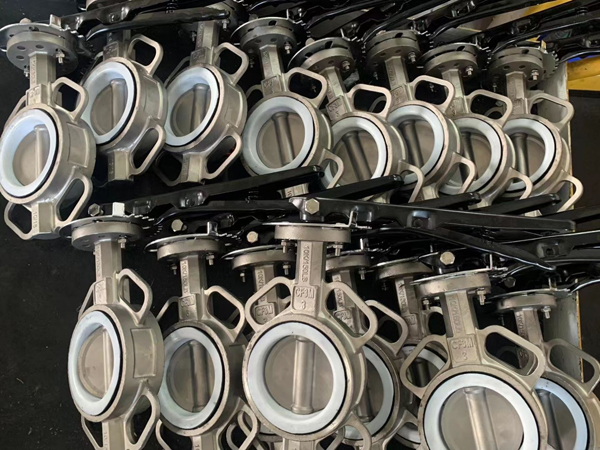
Conclusion
Selecting the right wafer valve type for your specific application is critical to ensuring optimal performance, efficiency, and longevity of your system. As you weigh your options and make a decision, it is essential to consider several key factors that impact the suitability of various wafer valve types. By taking these factors into account, you can make an informed choice that aligns with your unique requirements and delivers the desired outcomes.
- Application Requirements: The first and foremost consideration should be the specific needs of your application. This includes evaluating the type of fluid being controlled, operating pressure, temperature, flow rate, and any unique characteristics of the system, such as the presence of abrasive or corrosive substances. Understanding these requirements will help you determine which wafer valve type – butterfly, check, or other – is best suited to handle the demands of your particular application.
- Valve Functionality: Different wafer valve types serve distinct purposes, such as regulating flow, preventing backflow, or isolating sections of a pipeline. It is crucial to select a valve that performs the required function effectively and reliably. For instance, butterfly valves are ideal for flow regulation in low-pressure systems, while wafer check valves excel at preventing backflow in high-pressure applications.
- Material Compatibility: The materials used in constructing the wafer valve should be compatible with the fluids being handled and the environmental conditions of the system. This helps to avoid corrosion, wear, and premature failure. Common materials include stainless steel, brass, bronze, and various plastic or elastomeric components, each with their own advantages and limitations.
- Size and Installation Space: Wafer valves come in a variety of sizes to accommodate different pipeline diameters. It is vital to choose a valve that fits seamlessly within your system’s dimensions and installation space. Additionally, wafer valve types like butterfly valves are known for their compact design, making them an ideal choice when space constraints are a concern.
- Ease of Maintenance: Regular maintenance is essential to ensuring the long-term functionality and reliability of any valve. Select a wafer valve type that is easy to maintain, inspect, and replace if necessary. Some wafer valve designs, such as wafer check valves, offer minimal maintenance requirements due to their simple construction and lack of moving parts.
- Cost-effectiveness: While the initial cost of the valve is an important consideration, it is equally crucial to evaluate the long-term costs associated with operation, maintenance, and potential downtime. Select a wafer valve type that offers a balance between upfront cost and long-term value, ensuring that the investment delivers reliable performance and a favorable return on investment.
- Regulatory Compliance: Depending on your industry and location, there may be specific regulations and standards governing the use of wafer valves in your system. Ensure that the chosen wafer valve type complies with all relevant regulatory requirements and meets industry standards, such as those set by the American Petroleum Institute (API) or the International Organization for Standardization (ISO).
In conclusion, the selection of an appropriate wafer valve type requires careful consideration of various factors that influence the valve’s performance, compatibility, and overall value. By taking the time to thoroughly assess your application’s needs and weighing the pros and cons of different wafer valve types, you can make a well-informed decision that contributes to the efficiency, safety, and longevity of your system.
Recap of key factors to consider when selecting a wafer valve type
In summary, selecting the ideal wafer valve type for your application involves a comprehensive evaluation of several key factors. These include understanding your application requirements, identifying the desired valve functionality, ensuring material compatibility with the fluids and environmental conditions, considering size and installation space constraints, prioritizing ease of maintenance, assessing cost-effectiveness, and adhering to relevant regulatory compliance and industry standards. By carefully examining these crucial aspects, you can make an informed decision that leads to optimal performance, reliability, and longevity of your wafer valve and overall system.

Importance of consulting with experts and suppliers
The importance of consulting with experts and suppliers when selecting a wafer valve type, or any industrial component, cannot be overstated. Engaging with knowledgeable professionals in the field provides invaluable insights and guidance in navigating the complex decision-making process. Experts and suppliers possess extensive experience and understanding of various applications, materials, and industry-specific requirements, enabling them to offer tailored recommendations based on your unique needs. Furthermore, they can help identify potential challenges, suggest innovative solutions, and ensure that the chosen wafer valve aligns with your system’s performance, safety, and regulatory standards. By fostering a collaborative relationship with experts and suppliers, you not only benefit from their expertise but also contribute to the long-term success and efficiency of your project.


